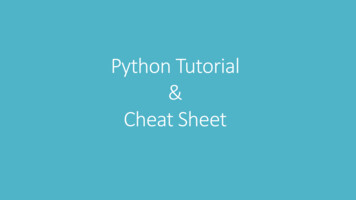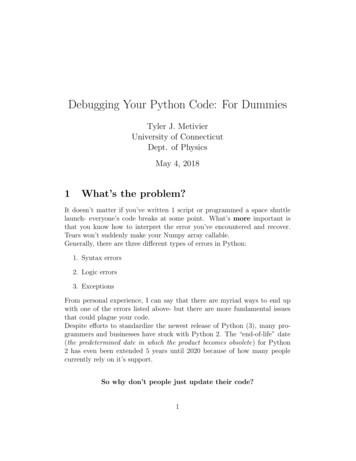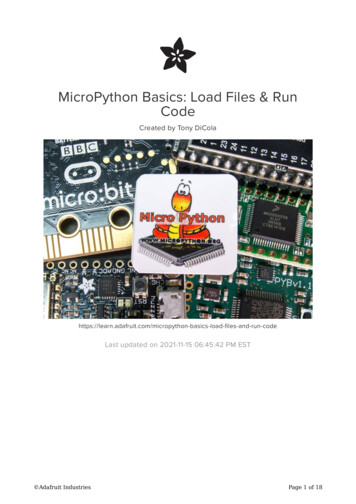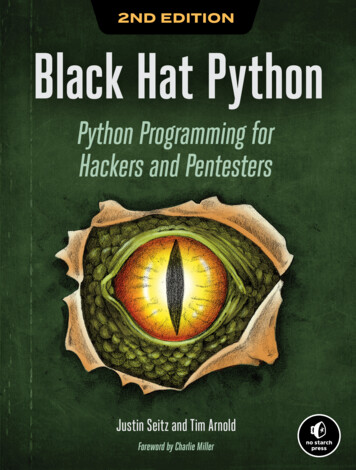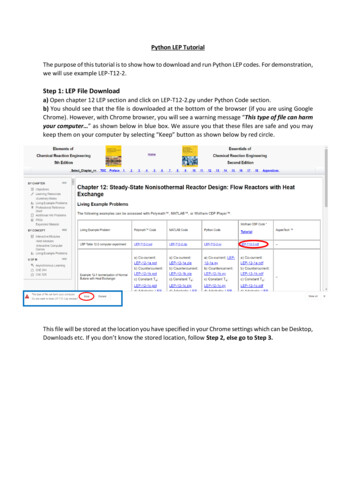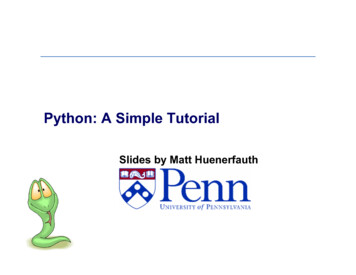
Transcription
Python: A Simple TutorialSlides by Matt Huenerfauth
Python Python is an open source scripting language.Developed by Guido van Rossum in the early 1990sNamed after Monty PythonAvailable on lab computersAvailable for download from http://www.python.org
Why Python? Very Object Oriented Python much less verbose than Java NLP Processing: Symbolic Python has built-in datatypes for strings, lists, and more. NLP Processing: Statistical Python has strong numeric processing capabilities: matrixoperations, etc. Suitable for probability and machine learning code. NLTK: Natural Language Tool Kit Widely used for teaching NLPFirst developed for this courseImplemented as a set of Python modulesProvides adequate libraries for many NLP building blocks Google “NLTK” for more info, code, data sets, book.
The Power of NLTK & Good Libraries
Technical IssuesInstalling & Running Python
The Python Interpreter Interactive interface to Python% pythonPython 2.5 (r25:51908, May 25 2007, 16:14:04)[GCC 4.1.2 20061115 (prerelease) (SUSE Linux)] on linux2Type "help", "copyright", "credits" or "license" for more information. Python interpreter evaluates inputs: 3*(7 2)27
The IDLE GUI Environment (Windows)
IDLE Development Environment Shell for interactive evaluation. Text editor with color-coding and smart indentingfor creating Python files. Menu commands for changing system settingsand running files.
Running Interactively on UNIXOn Unix % python 3 36 Python prompts with ʻ ʼ. To exit Python (not Idle): In Unix, type CONTROL-D In Windows, type CONTROL-Z Enter
Running Programs on UNIX% python filename.pyYou can create python files using emacs.(Thereʼs a special Python editing mode for xemacsand emacs-22. Can download for emacs-21.M-x load-file python-mode.elc)You could even make the *.py file executable andadd the following text to top of the file to make itrunable: #!/usr/bin/python
The Basics
A Code Samplex 34 - 23# A commenty “Hello”# Another one.z 3.45if z 3.45 or y “Hello”:x x 1y y “ World”# String concat.print xprint y
Our Code Sample in IDLEx 34 - 23# A comment.y “Hello”# Another one.z 3.45if z 3.45 or y “Hello”:x x 1y y “ World” # String concat.print xprint y
Enough to Understand the Code Assignment uses and comparison uses . For numbers - * / % are as expected. Special use of for string concatenation. Special use of % for string formatting (as with printf in C) Logical operators are words (and, or, not)not symbols The basic printing command is print. The first assignment to a variable creates it. Variable types donʼt need to be declared. Python figures out the variable types on its own.
Basic Datatypes Integers (default for numbers)z 5 / 2# Answer is 2, integer division. Floatsx 3.456 Strings Can use “” or ʻʼ to specify.“abc” ʻabcʼ (Same thing.) Unmatched can occur within the string.“mattʼs” Use triple double-quotes for multi-line strings or strings than containboth ʻ and “ inside of them:“““aʻb“c”””
WhitespaceWhitespace is meaningful in Python: especiallyindentation and placement of newlines. Use a newline to end a line of code. Use \ when must go to next line prematurely. No braces { } to mark blocks of code in Python Use consistent indentation instead. The first line with less indentation is outside of the block. The first line with more indentation starts a nested block Often a colon appears at the start of a new block.(E.g. for function and class definitions.)
Comments Start comments with # – the rest of line is ignored. Can include a “documentation string” as the first line ofany new function or class that you define. The development environment, debugger, and other toolsuse it: itʼs good style to include one.def my function(x, y):“““This is the docstring. Thisfunction does blah blah blah.”””# The code would go here.
Assignment Binding a variable in Python means setting a name to holda reference to some object. Assignment creates references, not copies Names in Python do not have an intrinsic type. Objectshave types. Python determines the type of the reference automatically based onthe data object assigned to it. You create a name the first time it appears on the left sideof an assignment expression:x 3 A reference is deleted via garbage collection after anynames bound to it have passed out of scope.
Accessing Non-Existent Names If you try to access a name before itʼs been properlycreated (by placing it on the left side of an assignment),youʼll get an error. yTraceback (most recent call last):File " pyshell#16 ", line 1, in -toplevelyNameError: name ʻy' is not defined y 3 y3
Multiple Assignment You can also assign to multiple names at the same time. x, y 2, 3 x2 y3
Naming Rules Names are case sensitive and cannot start with a number.They can contain letters, numbers, and underscores.bobBobbob2 bobbob 2BoB There are some reserved words:and, assert, break,elif, else, except,global, if, import,pass, print, raise,class, continue, def, del,exec, finally, for, from,in, is, lambda, not, or,return, try, while
Assignment (redundant) Binding a variable in Python means setting aname to hold a reference to some object. Assignment creates references, not copies Names in Python do not have an intrinsic type.Objects have types. Python determines the type of the reference automaticallybased on what data is assigned to it. You create a name the first time it appears on theleft side of an assignment expression:x 3 A reference is deleted via garbage collection afterany names bound to it have passed out of scope. Python uses reference semantics (more later)
Accessing Non-Existent Names(redundant) If you try to access a name before itʼs been properlycreated (by placing it on the left side of an assignment),youʼll get an error. yTraceback (most recent call last):File " pyshell#16 ", line 1, in -toplevelyNameError: name ʻy' is not defined y 3 y3
Sequence types:Tuples, Lists, and Strings
Sequence Types1. Tuple A simple immutable ordered sequence of itemsItems can be of mixed types, including collection types2. Strings Immutable Conceptually very much like a tuple3. List Mutable ordered sequence of items of mixed types
Similar Syntax All three sequence types (tuples, strings, andlists) share much of the same syntax andfunctionality. Key difference: Tuples and strings are immutable Lists are mutable The operations shown in this section can beapplied to all sequence types most examples will just show the operationperformed on one
Sequence Types 1 Tuples are defined using parentheses (and commas). tu (23, ʻabcʼ, 4.56, (2,3), ʻdefʼ) Lists are defined using square brackets (and commas). li [“abc”, 34, 4.34, 23] Strings are defined using quotes (“, ʻ, or “““). st st ststring “Hello World” ʻHello Worldʼ “““This is a multi-linethat uses triple quotes.”””
Sequence Types 2 We can access individual members of a tuple, list, or stringusing square bracket “array” notation. Note that all are 0 based tu (23, ʻabcʼ, 4.56, (2,3), ʻdefʼ) tu[1]# Second item in the tuple.ʻabcʼ li [“abc”, 34, 4.34, 23] li[1]# Second item in the list.34 st “Hello World” st[1]# Second character in string.ʻeʼ
Positive and negative indices t (23, ʻabcʼ, 4.56, (2,3), ʻdefʼ)Positive index: count from the left, starting with 0. t[1]ʻabcʼNegative lookup: count from right, starting with –1. t[-3]4.56
Slicing: Return Copy of a Subset 1 t (23, ʻabcʼ, 4.56, (2,3), ʻdefʼ)Return a copy of the container with a subset of the originalmembers. Start copying at the first index, and stop copyingbefore the second index. t[1:4](ʻabcʼ, 4.56, (2,3))You can also use negative indices when slicing. t[1:-1](ʻabcʼ, 4.56, (2,3))
Slicing: Return Copy of a Subset 2 t (23, ʻabcʼ, 4.56, (2,3), ʻdefʼ)Omit the first index to make a copy starting from the beginningof the container. t[:2](23, ʻabcʼ)Omit the second index to make a copy starting at the firstindex and going to the end of the container. t[2:](4.56, (2,3), ʻdefʼ)
Copying the Whole SequenceTo make a copy of an entire sequence, you can use [:]. t[:](23, ʻabcʼ, 4.56, (2,3), ʻdefʼ)Note the difference between these two lines for mutablesequences: list2 list1# 2 names refer to 1 ref# Changing one affects both list2 list1[:] # Two independent copies, two refs
The ʻinʼ Operator Boolean test whether a value is inside a container: t 3False 4True 4False [1, 2, 4, 5]in tin tnot in t For strings, tests for substrings a 'abcde' 'c' in aTrue 'cd' in aTrue 'ac' in aFalse Be careful: the in keyword is also used in the syntax offor loops and list comprehensions.
The Operator The operator produces a new tuple, list, or string whosevalue is the concatenation of its arguments. (1, 2, 3) (4, 5, 6)(1, 2, 3, 4, 5, 6) [1, 2, 3] [4, 5, 6][1, 2, 3, 4, 5, 6] “Hello” “ ” “World”ʻHello Worldʼ
The * Operator The * operator produces a new tuple, list, or string that“repeats” the original content. (1, 2, 3) * 3(1, 2, 3, 1, 2, 3, 1, 2, 3) [1, 2, 3] * 3[1, 2, 3, 1, 2, 3, 1, 2, 3] “Hello” * 3ʻHelloHelloHelloʼ
Mutability:Tuples vs. Lists
Tuples: Immutable t (23, ʻabcʼ, 4.56, (2,3), ʻdefʼ) t[2] 3.14Traceback (most recent call last):File " pyshell#75 ", line 1, in -topleveltu[2] 3.14TypeError: object doesn't support item assignmentYou canʼt change a tuple.You can make a fresh tuple and assign its reference to a previouslyused name. t (23, ʻabcʼ, 3.14, (2,3), ʻdefʼ)
Lists: Mutable li [ʻabcʼ, 23, 4.34, 23] li[1] 45 li[ʻabcʼ, 45, 4.34, 23] We can change lists in place. Name li still points to the same memory reference whenweʼre done. The mutability of lists means that they arenʼt as fast astuples.
Operations on Lists Only 1 li [1, 11, 3, 4, 5] li.append(ʻaʼ) # Our first exposure to method syntax li[1, 11, 3, 4, 5, ʻaʼ] li.insert(2, ʻiʼ) li[1, 11, ʻiʼ, 3, 4, 5, ʻaʼ]
The extend method vs the operator. creates a fresh list (with a new memory reference)extend operates on list li in place. li.extend([9, 8, 7]) li[1, 2, ʻiʼ, 3, 4, 5, ʻaʼ, 9, 8, 7]Confusing: Extend takes a list as an argument. Append takes a singleton as an argument. li.append([10, 11, 12]) li[1, 2, ʻiʼ, 3, 4, 5, ʻaʼ, 9, 8, 7, [10, 11, 12]]
Operations on Lists Only 3 li [ʻaʼ, ʻbʼ, ʻcʼ, ʻbʼ] li.index(ʻbʼ)1# index of first occurrence li.count(ʻbʼ)2# number of occurrences li.remove(ʻbʼ) li[ʻaʼ, ʻcʼ, ʻbʼ]# remove first occurrence
Operations on Lists Only 4 li [5, 2, 6, 8] li.reverse() li[8, 6, 2, 5]# reverse the list *in place* li.sort() li[2, 5, 6, 8]# sort the list *in place* li.sort(some function)# sort in place using user-defined comparison
Tuples vs. Lists Lists slower but more powerful than tuples. Lists can be modified, and they have lots of handy operations wecan perform on them. Tuples are immutable and have fewer features. To convert between tuples and lists use the list() and tuple()functions:li list(tu)tu tuple(li)
Understanding Reference Semantics inPython(Adapts several slides byGuido van Rossum)
Understanding Reference Semantics Assignment manipulates references—x y does not make a copy of the object y references—x y makes x reference the object y references Very useful; but beware! Example: a [1, 2, 3] b a a.append(4) print b[1, 2, 3, 4]Why?# a now references the list [1, 2, 3]# b now references what a references# this changes the list a references# if we print what b references,# SURPRISE! It has changed
Understanding Reference Semantics II There is a lot going on when we type: x 3First, an integer 3 is created and stored in memoryA name x is createdAn reference to the memory location storing the 3 is thenassigned to the name xSo: When we say that the value of x is 3we mean that x now refers to the integer 3Name: xRef: address1 Type: IntegerData: 3name listmemory
Understanding Reference Semantics III The data 3 we created is of type integer. In Python, thedatatypes integer, float, and string (and tuple) are“immutable.” This doesnʼt mean we canʼt change the value of x, i.e.change what x refers to For example, we could increment x: x 3 x x 1 print x4
Understanding Reference Semantics IV If we increment x, then whatʼs really happening is:1. The reference of name x is looked up.2. The value at that reference is retrieved.Name: xRef: address1 Type: IntegerData: 3 x x 1
Understanding Reference Semantics IV If we increment x, then whatʼs really happening is:1. The reference of name x is looked up. x x 12. The value at that reference is retrieved.3. The 3 1 calculation occurs, producing a new data element 4 whichis assigned to a fresh memory location with a new reference.Name: xRef: address1 Type: IntegerData: 3Type: IntegerData: 4
Understanding Reference Semantics IV If we increment x, then whatʼs really happening is:1. The reference of name x is looked up. x x 12. The value at that reference is retrieved.3. The 3 1 calculation occurs, producing a new data element 4which is assigned to a fresh memory location with a newreference.4. The name x is changed to point to this new reference.Name: xRef: address1 Type: IntegerData: 3Type: IntegerData: 4
Understanding Reference Semantics IV If we increment x, then whatʼs really happening is:1. The reference of name x is looked up. x x 12. The value at that reference is retrieved.3. The 3 1 calculation occurs, producing a new data element 4which is assigned to a fresh memory location with a newreference.4. The name x is changed to point to this new reference.5. The old data 3 is garbage collected if no name still refers to it.Name: xRef: address1 Type: IntegerData: 4
Assignment 1 So, for simple built-in datatypes (integers, floats, strings),assignment behaves as you would expect: 3x 3y xy 4print x####Creates 3, nameCreates name y,Creates ref forNo effect on x,x refers to 3refers to 3.4. Changes y.still ref 3.
Assignment 1 So, for simple built-in datatypes (integers, floats, strings),assignment behaves as you would expect: 3x 3y xy 4print x####Creates 3, nameCreates name y,Creates ref forNo effect on x,Name: xRef: address1 x refers to 3refers to 3.4. Changes y.still ref 3.Type: IntegerData: 3
Assignment 1 So, for simple built-in datatypes (integers, floats, strings),assignment behaves as you would expect: 3x 3y xy 4print x####Creates 3, nameCreates name y,Creates ref forNo effect on x,Name: xRef: address1 Name: yRef: address1 x refers to 3refers to 3.4. Changes y.still ref 3.Type: IntegerData: 3
Assignment 1 So, for simple built-in datatypes (integers, floats, strings),assignment behaves as you would expect: 3x 3y xy 4print x####Creates 3, nameCreates name y,Creates ref forNo effect on x,Name: xRef: address1 Name: yRef: address1 x refers to 3refers to 3.4. Changes y.still ref 3.Type: IntegerData: 3Type: IntegerData: 4
Assignment 1 So, for simple built-in datatypes (integers, floats, strings),assignment behaves as you would expect: 3x 3y xy 4print x####Creates 3, nameCreates name y,Creates ref forNo effect on x,Name: xRef: address1 Name: yRef: address2 x refers to 3refers to 3.4. Changes y.still ref 3.Type: IntegerData: 3Type: IntegerData: 4
Assignment 1 So, for simple built-in datatypes (integers, floats, strings),assignment behaves as you would expect: 3x 3y xy 4print x####Creates 3, nameCreates name y,Creates ref forNo effect on x,Name: xRef: address1 Name: yRef: address2 x refers to 3refers to 3.4. Changes y.still ref 3.Type: IntegerData: 3Type: IntegerData: 4
Assignment 2 For other data types (lists, dictionaries, user-defined types),assignment works differently. These datatypes are “mutable.”When we change these data, we do it in place.We donʼt copy them into a new memory address each time.If we type y x and then modify y, both x and y are changed.immutable 3x 3y xy 4print xmutablex some mutable objecty xmake a change to ylook at xx will be changed as well
Why? Changing a Shared Lista [1, 2, 3]a123123123ab abaa.append(4)b4
Our surprising example surprising no more. So now, hereʼs our code: a [1, 2, 3] b a a.append(4) print b[1, 2, 3, 4]# a now references the list [1, 2, 3]# b now references what a references# this changes the list a references# if we print what b references,# SURPRISE! It has changed
Dictionaries
Dictionaries: A Mapping type Dictionaries store a mapping between a set of keysand a set of values. Keys can be any immutable type. Values can be any type A single dictionary can store values of different types You can define, modify, view, lookup, and deletethe key-value pairs in the dictionary.
Creating and accessing dictionaries d {ʻuserʼ:ʻbozoʼ, ʻpswdʼ:1234} d[ʻuserʼ]ʻbozoʼ d[ʻpswdʼ]1234 d[ʻbozoʼ]Traceback (innermost last):File ʻ interactive input ʼ line 1, in ?KeyError: bozo
Updating Dictionaries d {ʻuserʼ:ʻbozoʼ, ʻpswdʼ:1234} d[ʻuserʼ] ʻclownʼ d{ʻuserʼ:ʻclownʼ, ʻpswdʼ:1234} Keys must be unique.Assigning to an existing key replaces its value. d[ʻidʼ] 45 d{ʻuserʼ:ʻclownʼ, ʻidʼ:45, ʻpswdʼ:1234} Dictionaries are unordered New entry might appear anywhere in the output.(Dictionaries work by hashing)
Removing dictionary entries d {ʻuserʼ:ʻbozoʼ, ʻpʼ:1234, ʻiʼ:34} del d[ʻuserʼ] d{ʻpʼ:1234, ʻiʼ:34}# Remove one. d.clear() d{}# Remove all.
Useful Accessor Methods d {ʻuserʼ:ʻbozoʼ, ʻpʼ:1234, ʻiʼ:34} d.keys()[ʻuserʼ, ʻpʼ, ʻiʼ]# List of keys. d.values()[ʻbozoʼ, 1234, 34]# List of values. d.items()# List of item tuples.[(ʻuserʼ,ʻbozoʼ), (ʻpʼ,1234), (ʻiʼ,34)]
Functions in Python
Defining FunctionsFunction definition begins with “def.”Function name and its arguments.def get final answer(filename):“Documentation String”line1line2return total counterThe indentation matters First line with lessindentation is considered to beoutside of the function definition.Colon.The keyword ʻreturnʼ indicates thevalue to be sent back to the caller.No header file or declaration of types of function or arguments.
Python and TypesPython determines the data types of variablebindings in a program automatically.But Pythonʼs not casual about types, itenforces the types of objects.“Dynamic Typing”“Strong Typing”So, for example, you canʼt just append an integer to a string. Youmust first convert the integer to a string itself.x “the answer is ” # Decides x is bound to a string.y 23# Decides y is bound to an integer.print x y# Python will complain about this.
Calling a Function The syntax for a function call is: def myfun(x, y):return x * y myfun(3, 4)12 Parameters in Python are “Call by Assignment.” Sometimes acts like “call by reference” and sometimes like “call byvalue” in C .— Mutable datatypes: Call by reference.— Immutable datatypes: Call by value.
Functions without returns All functions in Python have a return value even if no return line inside the code. Functions without a return return the special valueNone. None is a special constant in the language.None is used like NULL, void, or nil in other languages.None is also logically equivalent to False.The interpreter doesnʼt print None
Function overloading? No. There is no function overloading in Python. Unlike C , a Python function is specified by its name alone— The number, order, names, or types of its arguments cannotbe used to distinguish between two functions with the samename. Two different functions canʼt have the same name, even ifthey have different arguments. But: see operator overloading in later slides(Note: van Rossum playing with function overloading for the future)
Functions are first-class objects in Python Functions can be used as any other data type They can be Arguments to functionReturn values of functionsAssigned to variablesParts of tuples, lists, etc def myfun(x):return x*3 def applier(q, x):return q(x) applier(myfun, 7)21
Logical Expressions
True and False True and False are constants in Python. Other values equivalent to True and False: False: zero, None, empty container or object True: non-zero numbers, non-empty objects Comparison operators: , ! , , , etc. X and Y have same value: X Y Compare with X is Y :—X and Y are two variables that refer to the identical sameobject.
Boolean Logic Expressions You can also combine Boolean expressions. true if a is true and b is true: true if a is true or b is true: true if a is false:a and ba or bnot a Use parentheses as needed to disambiguatecomplex Boolean expressions.
Special Properties of and and or Actually and and or donʼt return True or False. They return the value of one of their sub-expressions(which may be a non-Boolean value). X and Y and Z If all are true, returns value of Z. Otherwise, returns value of first false sub-expression. X or Y or Z If all are false, returns value of Z. Otherwise, returns value of first true sub-expression. And and or use lazy evaluation, so no further expressionsare evaluated
The “and-or” Trick A trick to implement a simple conditionalresult test and expr1 or expr2 When test is True, result is assigned expr1. When test is False, result is assigned expr2. Works almost like (test ? expr1 : expr2) expression of C . But if the value of expr1 is ever False, the trick doesnʼt work. Avoid (hard to debug), but you may see it in the code. Made unnecessary by conditional expressions in Python 2.5(see next slide)
Conditional Expressions: New in Python 2.5 x true value if condition else false value Uses lazy evaluation: First, condition is evaluated If True, true value is evaluated and returned If False, false value is evaluated and returned Suggested use: x (true value if condition else false value)
Control of Flow
Control of Flow There are several Python expressions that controlthe flow of a program. All of them make use ofBoolean conditional tests. if Statements while Loops assert Statements
if Statementsif x 3:print “X equals 3.”elif x 2:print “X equals 2.”else:print “X equals something else.”print “This is outside the ʻifʼ.”Be careful! The keyword if is also used in the syntaxof filtered list comprehensions.Note: Use of indentation for blocks Colon (:) after boolean expression
while Loopsx 3while x 10:x x 1print “Still in the loop.”print “Outside of the loop.”
break and continue You can use the keyword break inside a loop toleave the while loop entirely. You can use the keyword continue inside a loopto stop processing the current iteration of theloop and to immediately go on to the next one.
assert An assert statement will check to make sure thatsomething is true during the course of a program. If the condition if false, the program stops.assert(number of players 5)
Generating Lists using“List Comprehensions”
List Comprehensions A powerful feature of the Python language. Generate a new list by applying a function to every memberof an original list. Python programmers use list comprehensions extensively.Youʼll see many of them in real code. The syntax of a list comprehension is somewhattricky. Syntax suggests that of a for-loop, an in operation, or an ifstatement—all three of these keywords (ʻforʼ, ʻinʼ, and ʻifʼ) are also usedin the syntax of forms of list comprehensions.
Using List Comprehensions 1 li [3, 6, 2, 7] [elem*2 for elem in li][6, 12, 4, 14]Note: Non-standardcolors on next severalslides to help clarifythe list comprehensionsyntax.[ expression for name in list ] Where expression is some calculation or operation actingupon the variable name. For each member of the list, the list comprehension1. sets name equal to that member,2. calculates a new value using expression, It then collects these new values into a list which is the returnvalue of the list comprehension.
Using List Comprehensions 2[ expression for name in list ] If list contains elements of different types, then expressionmust operate correctly on the types of all of list members. If the elements of list are other containers, then the namecan consist of a container of names that match the type and“shape” of the list members. li [(ʻaʼ, 1), (ʻbʼ, 2), (ʻcʼ, 7)] [ n * 3 for (x, n) in li][3, 6, 21]
Using List Comprehensions 3[ expression for name in list ] expression can also contain user-definedfunctions. def subtract(a, b):return a – b oplist [(6, 3), (1, 7), (5, 5)] [subtract(y, x) for (x, y) in oplist][-3, 6, 0]
Filtered List Comprehension 1[expression for name in list if filter] Filter determines whether expression is performed on eachmember of the list. For each element of list, checks if it satisfies the filtercondition. If it returns False for the filter condition, it is omitted from thelist before the list comprehension is evaluated.
Filtered List Comprehension 2[ expression for name in list if filter ] li [3, 6, 2, 7, 1, 9] [elem * 2 for elem in li if elem 4][12, 14, 18] Only 6, 7, and 9 satisfy the filter condition. So, only 12, 14, and 18 are produced.
Nested List Comprehensions Since list comprehensions take a list as input and producea list as output, they are easily nested: li [3, 2, 4, 1] [elem*2 for elem in[item 1 for item in li] ][8, 6, 10, 4] The inner comprehension produces: [4, 3, 5, 2]. So, the outer one produces: [8, 6, 10, 4].
For Loops
For Loops / List Comprehensions Pythonʼs list comprehensions and split/joinoperations provide natural idioms that usuallyrequire a for-loop in other programminglanguages. As a result, Python code uses many fewer for-loops Nevertheless, itʼs important to learn about for-loops. Caveat! The keywords for and in are also used inthe syntax of list comprehensions, but this is atotally different construction.
For Loops 1Note: Nonstandard colorson these slides. A for-loop steps through each of the items in a list, tuple,string, or any other type of object which is “iterable”for item in collection : statements If collection is a list or a tuple, then the loop stepsthrough each element of the sequence. If collection is a string, then the loop steps through eachcharacter of the string.for someChar in “Hello World”:print someChar
For Loops 2for item in collection : statements item can be more complex than a single variable name. When the elements of collection are themselves sequences,then item can match the structure of the elements. This multiple assignment can make it easier to access theindividual parts of each element.for (x, y) in [(a,1), (b,2), (c,3), (d,4)]:print x
For loops and the range() function Since a variable often ranges over some sequence ofnumbers, the range() function returns a list of numbersfrom 0 up to but not including the number we pass to it. range(5) returns [0,1,2,3,4] So we could say:for x in range(5):print x (There are more complex forms of range() that providericher functionality )
Some Fancy Function Syntax
Lambda Notation Functions can be defined without giving them names.This is most useful when passing a short function as anargument to another function. applier(lambda z: z * 4, 7)28 The first argument to applier() is an unnamed function thattakes one input and returns the input multiplied by four.Note: only single-expression functions can be definedusing this lambda notation.Lambda notation has a rich history in program languageresearch, AI, and the design of the LISP language.
Default Values for Arguments You can provide default values for a functionʼs arguments These arguments are optional when the function is called def myfun(b, c 3, d “hello”):return b c myfun(5,3,”hello”) myfun(5,3) myfun(5)All of the above function calls return 8.
The Order of Arguments You can call a function with some or all of its arguments out oforder as long as you specify them (these are called keywordarguments). You can also just use keywords for a final subset ofthe arguments. def myfun(a, b, c):return a-b myfun(2, 1, 43)1 myfun(c 43, b 1, a 2)1 myfun(2, c 43, b 1)1
Assignment and Containers
Multiple Assignment with Sequences Weʼve seen multiple assignment before: x, y 2, 3 But you can also do it with sequences. The type and “shape” just has to match. (x, y, (w, z)) (2, 3, (4, 5)) [x, y] [4, 5]
Empty Containers 1 Assignment creates a name, if it didnʼt exist already.x 3 Creates name x of type integer. Assignment is also what creates named references tocontainers. d {ʻaʼ:3, ʻbʼ:4} We can also create empty containers: li []Note: an empty container tu ()is logically equivalent to di {}False. (Just like None.) These three are empty, but of different types
Empty Containers 2 Why create a named reference to empty container? To initialize an empty list, for example, before using append. This would cause an unknown name error a named reference tothe right data type wasnʼt created first g.append(3)Python complains here about the unknown name ʻgʼ! g [] g.append(3) g[3]
String Operations
String Operations A number of methods for the string class perform usefulformatting operations: “hello”.upper()ʻHELLOʼ Check the Python documentation for many other handystring operations. Helpful hint:
Python: A Simple Tutorial Slides by Matt Huenerfauth Python is an open source scripting language. . Python determines the type of the referen




